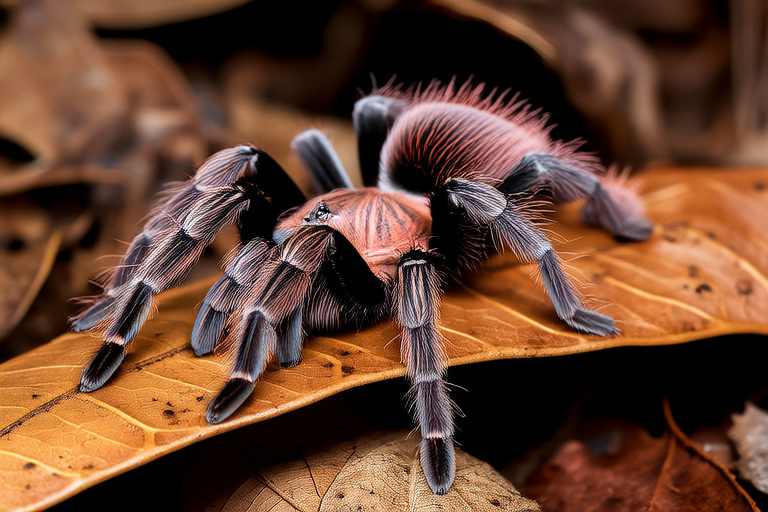Tarantula Tidbits: Discovering the Unique World of the Chilean Rose Tarantula
The world of tarantulas is often shrouded in mystery and fear, but there’s a species that has captured the hearts of many arachnophiles: the Chilean rose tarantula. With its captivating appearance and gentle demeanor, this spider stands out from its more fearsome cousins. Let’s delve into the unique world of the Chilean rose tarantula, exploring its habitat, diet, behavior, and care requirements.
Habitat and Diet
Native to the deserts and scrublands of South America, particularly in Chile, Argentina, and Peru, the Chilean rose tarantula (Grammostola rosea) thrives in arid environments. These spiders prefer dry, sandy regions where they can dig burrows to shelter themselves from predators and extreme weather conditions. Their natural habitat consists of sparse vegetation and rocky outcrops, providing ample hiding spots.
As opportunistic hunters, Chilean rose tarantulas feast on a variety of small prey, including insects like crickets, mealworms, and wax moths. In captivity, their diet can be supplemented with commercially available insect products. It’s important to ensure that the food items are appropriately sized to prevent digestive issues.
Behavior and Temperament
Contrary to popular belief, the Chilean rose tarantula is not aggressive or venomous to humans. Their venom is mild and primarily used for subduing prey. They are generally docile and slow-moving, making them ideal candidates for handling by experienced keepers. However, it’s crucial to handle them gently to avoid stressing the spider or causing injury.
These tarantulas exhibit fascinating behaviors such as molting, during which they shed their exoskeleton to grow. Molting is a critical phase in a tarantula’s life cycle, and it’s essential to provide a humid environment to aid in this process. Additionally, they are known for their ability to camouflage themselves by covering their bodies with sand or substrate, effectively blending into their surroundings.
Appearance and Popularity
The Chilean rose tarantula is named for its distinctive pinkish-brown coloration, which can vary slightly depending on the individual spider. Males tend to have longer legs and more vibrant colors compared to females. Their appearance is complemented by a dense covering of fine hairs, which they can release as a defense mechanism if threatened.
This tarantula’s popularity among enthusiasts stems from its manageable size, docile nature, and relatively low maintenance requirements. As a result, it’s often recommended as a first tarantula for beginners. However, it’s important to note that handling should be limited to reduce stress and potential injuries.
Care Requirements
Creating an appropriate living environment for a Chilean rose tarantula involves several key factors:
- Enclosure: A terrarium with adequate ventilation is essential. The enclosure should be large enough to allow the spider to move freely and accommodate a burrow. A substrate of coconut fiber, vermiculite, or a mix of sand and soil works well for creating a suitable environment.
- Temperature and Humidity: Maintaining a temperature range between 75°F and 85°F (24°C to 29°C) is optimal. Humidity levels should be kept moderate, around 60% to 70%, to prevent respiratory issues. Providing a shallow water dish can help maintain humidity levels.
- Lighting: While tarantulas don’t require UV lighting, a dim light source can be provided to create a day-night cycle. Avoid bright lights that may cause undue stress.
- Diet and Feeding: Feed your tarantula once or twice a week, offering appropriately sized insects. Ensure that the food items are dusted with calcium and vitamin supplements to promote healthy growth.
Tips for Potential Owners
Before deciding to bring a Chilean rose tarantula into your home, consider the following tips:
- Research: Thoroughly understand the specific needs and behaviors of the species. This will help you provide the best possible care.
- Prepare: Set up the enclosure correctly before bringing your new pet home. Proper preparation ensures that the spider feels secure and comfortable in its new environment.
- Patience: Allow your tarantula time to acclimate to its new surroundings. Handling should be done gently and infrequently to minimize stress.
- Commitment: Owning a tarantula requires a long-term commitment. Be prepared to care for your pet throughout its lifecycle, which can span several years.
Dispelling Common Misconceptions
One of the most common misconceptions about tarantulas is that they are dangerous to humans. While all tarantulas possess venom, the Chilean rose tarantula’s venom is too weak to harm a human. Another myth is that tarantulas are solitary and antisocial. In reality, while they are solitary in the wild, they can coexist peacefully in captivity if housed properly.
Additionally, some people believe that tarantulas are dirty and carry diseases. However, tarantulas are clean animals and do not pose any significant health risks to their owners. Regular cleaning of the enclosure and proper hygiene practices can prevent any potential issues.
Further Learning Resources
To deepen your understanding of the Chilean rose tarantula and other tarantulas, explore the following resources:
- Books: “The Tarantula Keeper’s Guide” by Stanley A. Schultz and Marguerite J. Schultz provides comprehensive information on tarantula care and husbandry.
- Websites: Visit forums and communities dedicated to tarantula enthusiasts for advice and support. Websites like Tarantula.com offer valuable insights and resources.
- Local Pet Stores: Many pet stores specializing in exotic animals host workshops and seminars on tarantula care. Attending these events can provide hands-on learning experiences.
The Chilean rose tarantula is a captivating and gentle creature that offers a unique perspective on the world of arachnids. By understanding their habitat, diet, behavior, and care requirements, you can provide a safe and enriching environment for these fascinating creatures. Whether you’re a seasoned enthusiast or a curious beginner, the Chilean rose tarantula promises an enlightening and rewarding experience.
